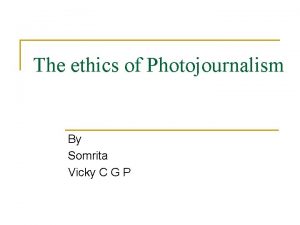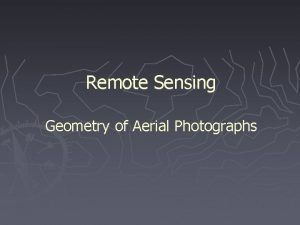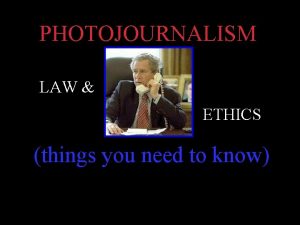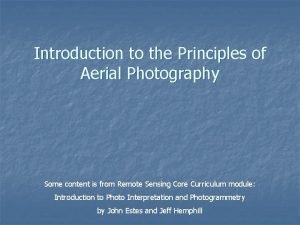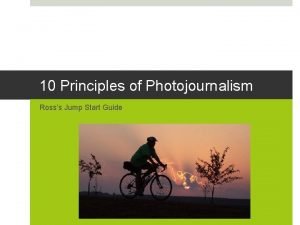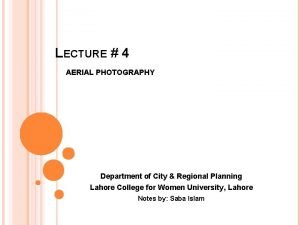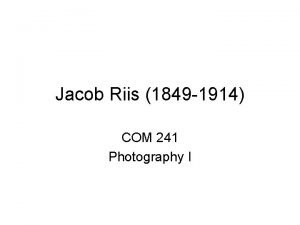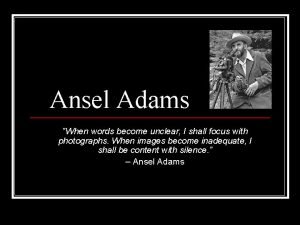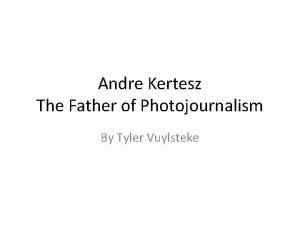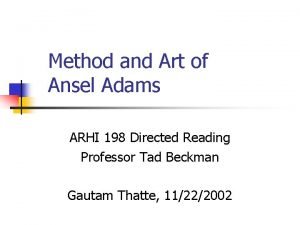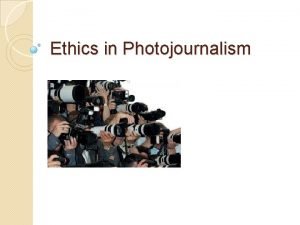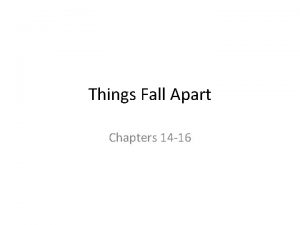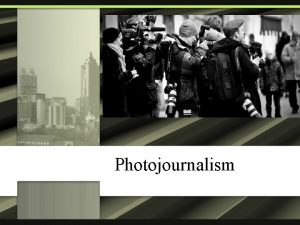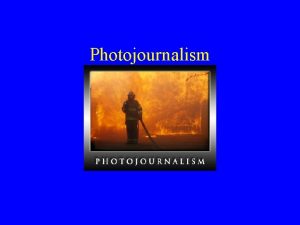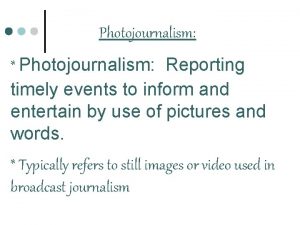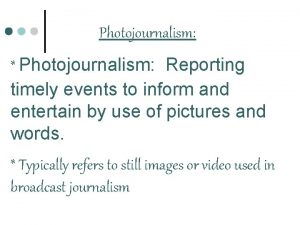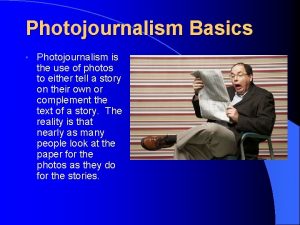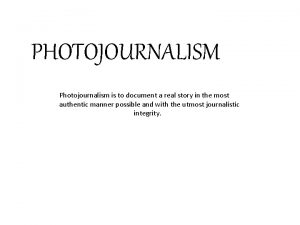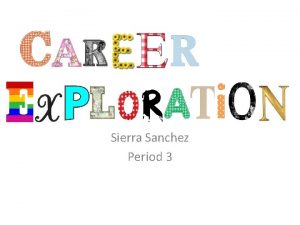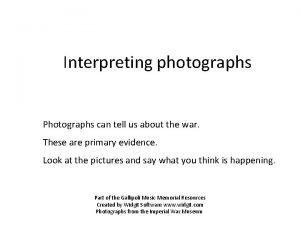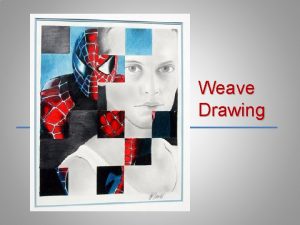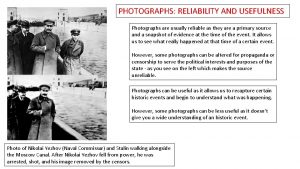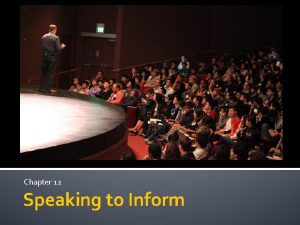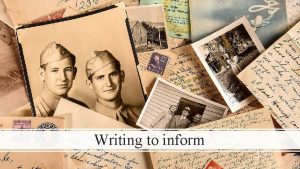PHOTOJOURNALISM CHAPTER 7 WE KNOW THAT PHOTOGRAPHS INFORM







































- Slides: 39

PHOTOJOURNALISM CHAPTER 7

WE KNOW THAT PHOTOGRAPHS INFORM PEOPLE. WE ALSO KNOW THAT PHOTOGRAPHS MOVE PEOPLE. THE PHOTOGRAPH THAT DOES BOTH IS THE ONE WE WANT TO SEE AND MAKE. Sam Abell, photojournalist

DOCUMENTARY PHOTOGRAPHS The most important part is that it tells a story The attitudes and feelings of the photographers come through their images. Emotional content that connects the viewer to the image and it’s subject They should always be truthful, nothing should be faked

THE JOB OF PHOTOJOURNALIST IS: Inform Us Intrigue Us Make Us Care But Never to Deceive US

Francis Frith HOW IT BEGAN 1839 Francis Frith began to photograph exotic locations like Egypt for audiences in England & Europe 1855 Roger Fenton used camera to document Crimean War in Europe (First War Photographs) mostly landscapes and posed soldiers 1861 -1865 Matthew Brady & Timothy O’Sullivan American Civil War Photographed actual battles and human casualties of war

Roger Fenton

Matthew Brady

Timothy H. O'Sullivan

SOCIAL CHANGES THROUGH PHOTOGRAPHY 1890 Jacob Riis New York Reporter Immigrant Living Conditions 1908 -1930 Lewis Hine Child Labor Walker Evans and Dorothea Lange documented victims of the Great Depression Margaret Bourke-White World War II combat and concentration camps Robert Capa most wars of the twentieth century 1970’s W. Eugene Smith Reveled Mercury pollution in Japanese Village Today’s Sebastian Salgado Eugene Richards

1890 JACOB RIIS New York Reporter Immigrant Living Conditions

1908 -1930 LEWIS HINE Child Labor

WALKER EVANS Great Depression As he stares out from the darkness behind him, the defeated expression in the man's eyes pulls the viewer into a time of extreme hardship. Although this stark black-and-white photograph was taken nearly 80 years ago, the current recession has brought renewed meaning to this and the many other iconic Depression-era photographs of American photographer Walker Evans (19031975).

DOROTHEA LANGE Great Depression I saw and approached the hungry and desperate mother, as if drawn by a magnet. I do not remember how I explained my presence or my camera to her, but I do remember she asked me no questions. I made five exposures, working closer and closer from the same direction. I did not ask her name or her history. She told me her age, that she was thirty-two. She said that they had been living on frozen vegetables from the surrounding fields, and birds that the children killed. She had just sold the tires from her car to buy food. There she sat in that lean- to tent with her children huddled around her, and seemed to know that my pictures might help her, and so she helped me. There was a sort of equality about it. (From: Popular Photography, Feb. 1960).

GORDON PARKS Acclaimed photographer Gordon Parks was LIFE magazine's first black photographer; his work became legendary. In 1956, Gordon traveled to Alabama for LIFE to document the segregated South with writer Robert Wallace. Later that year in September, LIFE published 26 of Parks' photos in the story titled, "The Restraints: Open and Hidden. " Throughout his career Parks pursued social justice with his camera. His "quiet" images of daily life in Alabama, as published in "The Restraints, " brought the reality of segregation to the public's consciousness in a profound way.

MARGARET BOURKEWHITE World War II combat and concentration camps Margaret Bourke-White was the first foreign photographer allowed to take pictures of Soviet industry, the first female war correspondent, the first woman permitted to work in combat zones, and the first female photographer for Henry Luce's. Life magazine. There are many other firsts, but you get the idea. Along with Dorothea Lange and two or three others, these women nudged aside their male counterparts at a time when such nudging seldom happened, and was looked down upon when it did. Bourke. White was among the first war correspondents (of either gender) allowed to photograph survivors of the Jewish Holocaust when concentration camps such as Buchenwald were liberated

ROBERT CAPA Most wars of the twentieth century When soldiers of the 16 th Regiment of the 1 st Infantry Division landed at Omaha Beach on June 6, 1944, photographer Robert Capa, in the employ of LIFE magazine, was among them. Perhaps the best known of all World War II combat photographers, the Hungarian-born Capa had made a name for himself well before climbing into a landing craft with men of Company E in the early morning hours of D-Day. He risked his life on more than one occasion during the Spanish Civil War and had taken what is considered the most eerily fascinating of all war photographs. The famous image reportedly depicts the death of Spanish Loyalist militiaman Frederico Borrell Garcia as he is struck in the chest by a Nationalist bullet on a barren Iberian hillside. Capa was known to say, "If your pictures aren't good enough, you aren't close enough. " On D-Day, he came close once again. With Capa standing in the very stern, his landing craft mistakenly came ashore at the section of Omaha Beach dubbed "Easy Red. " Then the ramp went down.

1970’S W. EUGENE SMITH Revealed Mercury pollution in Japanese Village

SEBASTIAN SALGADO Sebastião Salgado travels the world documenting the poor and powerless, as well as the grandeur of nature, in analog black-and-white photographs that are both highly formal and unflinchingly documentary.

EUGENE RICHARDS Eugene Richards, photographer, writer, and filmmaker, was born in Dorchester, Massachusetts in 1944. After graduating from Northeastern University with a degree in English, he studied photography with Minor White. In 1968, he joined VISTA, Volunteers in Service to America, a government program established as an arm of the socalled” War on Poverty. ” Following a year and a half in eastern Arkansas, Richards helped found a social service organization and a community newspaper, Many Voices, which reported on black political action as well as the Ku Klux Klan. Photographs he made during these four years were published in his first monograph, Few Comforts or Surprises: The Arkansas Delta.

STEVE MCCURRY Steve Mc. Curry is arguably the most famous portrait photographer of all time. His picture Afghan girl is one of the most recognizable portraits of all time. It has even been likened to Leonardo da Vinci's painting of the Mona Lisa.

JODI COBB Is the first woman to be a staff photographer for National Geographic magazine. Her job takes her around the world creating beautiful, striking pictures. She was the first photographer allowed access into the closed day lives of women in Saudi Arabia. Another hidden world for her book, Geisha

BECOMING A PHOTOJOURNALIST Think Artistically • Photojournalism conveys specific meanings related to certain people and/or events. • It’s important for people to read the message correctly 1990 Mary Ellen Mark Ram Prakash Singh with His Elephants Shyama

COMPOSITION CHOICES: • Viewpoint: • The level of your camera in relation to your subjects eyes • • • http: //www. nbcnews. com/slideshow/today-pictures-april 11 -n 554426 A schoolgirl is soaked with water thrown by an elephant in • a preview of the upcoming Songkran Festival celebration, the Thai traditional New Year, also known as the water festival in the ancient world heritage city of Ayutthaya, Thailand. The annual elephant Songkran is held to promote the tourism industry ahead of the three-day Songkran Festival which starts on April 13 -15 and is celebrated with splashing water and putting powder on faces as a symbolic sign of cleansing and washing away the sins from the old year. Eye level shots create intimacy • Shooting from below makes subject appear bigger • Shooting from above makes subject look smaller Timing • Is a critical element in photojournalism • It allows to capture the crucial moments • Capturing people in action Proportion: • How objects relate to one another in size • Making the subject the same size as the other objects gives equal importance • Making subjects bigger than other objects gives it primary importance Value • Refers to light and dark tones in your image • Mostly dark images are powerful, suspenseful, or threatening. • Mostly light images are associated with lighter, more upbeat emotions.

• Before you begin DOCUMENTARY SUBJECTS The goal of photojournalism is to tell a true story. • What is happening? • Why is it happening? • What is the most important aspect of the event? • How do people you are photographing feel about the event? • How do you feel about it? Photograph activities and subjects that best illustrate your feelings and impressions of the event

EXAMPLES • A day in the life of “____” Follow someone from morning until night, photographing the major and minor events of his or her typical day • Athletic Events • Music performances • Behind the scenes

THE SINGLE IMAGE • Newspapers and magazines are filled with single images that show us glimpses of other people’s lives. • The most successful of these images are dynamic compositions that are full of energy and life, and brimming with emotions and drama. • It’s impossible to tell a complete story about anything or anyone with one single-image documentary photographs try very hard to do just that. • Images should focus: • • People reacting to events • People doing their jobs • Enjoying hobbies • Performing Music Subjects: • Should be active, so you can photograph their reactions • Include some of the surroundings • So viewers know what is going on

THE PHOTO ESSAY • The photo-essay is similar to a documentary because it tries to capture events that really happened. • By illustrating a larger story with several images, the photographer can tell that story more completely, showing more aspects of the story and focusing on the smaller details that might otherwise be left out. • The photographer can also show the sequence of events in the story. • • Many photo essays are intended to become books • These stories require a larger commitment from the photographer A photo-essay has room for many different kinds of pictures. • Take some shots of the setting or scene • With or without people • Include architecture • Include landscapes • Get closer and focus on your subjects facial expressions • If they are working with their hands go in close for shot of hands • If they use tools photographs those

STREET PHOTOGRAPHY • Street photography combines the subject matter of photojournalism with the formal composition and symbolism of art photography. • Street photography can look a lot like photojournalism, except that is doesn’t really try to capture specific news events or stories. • It is more like art photography. • Its goal is to capture a single instant in time, when people and their surroundings come together in interesting and beautiful shapes and combinations.

FRAME AN IMAGE • Using the environment to frame an image • Look for parts of a scene that you could use to frame and isolate elements in an image. • Windows, doorways, arches, and other architectural elements ways to create a frame for your subject within the image. • This is a great way to focus a viewer’s attention on your subject. Dorothea Lange (American, 1895 -1965) Funeral Cortège, End of an Era in a Small Valley Town, California, 1938, printed later. Unsigned. Gelatin silver print, image/sheet size 8 5/8 x 7 5/8 in. , unframed. Condition: Mounted, good.

CAN PHOTOJOURNALISM AND PHOTOSHOP COEXIST? In some instances, photography has gone from being truthful, where “pictures never lie” to being deceptive. Digital photography has made image manipulation very easy to do. Most photojournalist feel that any manipulated image is a lie and should never be done. Substantially altering any photojournalistic image can’t be good for photograph’s reputation. Corrections to adjust contrast and color are okay, as well as minimal dodging and burning, but removing objects from the image or adding new ones should never be done.

FOR YOUR PORTFOLIO • Make a list of ten topics that are important to you. Choose one of them to expand list at least eight photos you might capture for that topic. • For example: • “A day in the life of a ballet student” might have images of rehearsal, bruised toes, costumes, musicians, a performance, injuries, friends, competition, cooperation, disappointments and fun. Examples of photo essays: http: //www. fastcodesign. com/3054576/the-22 -best-photo-essays-of-2015/21

CHAPTER REVIEW

RECALL • What is the most important aspect of documentary photography? • The most important is the images are truthful

UNDERSTAND • What problems can be created for photojournalists when parts of an image are changed or faked? • When the truth is known about photo manipulation, viewers will distrust the honesty and integrity of other photos by the photographer in question, or photographers in general, or the publication in which the image appeared.

APPLY • Create a truthful photograph that communicates what your lunchtime is really like. • Group Discussion

ANALYZE WHAT CHOICES DID MARK ELLEN MARK MAKE AND HOW DID THEY INFLUENCE THE FINAL IMAGE? 1. The choice of black and white 2. The viewpoint looks straight into man and elephants eyes 3. The timing leaves the viewer wondering 4. The shape of the trunk in a spiral leading to the man’s face 5. Eliminating any extreme background focuses the viewer’s attention on the subjects

SYNTHESIZE • Write a code of conduct or ethics for photojournalists. What do you think are important standards for photojournalists? Compare your answer with the code of ethics published by the national press photographers association. • https: //nppa. org/code_of_ethics

EVALUATE • What message does this photo communicate to you?

EVALUATE • While Weegee's work appeared in many American newspapers and magazines, his methods would sometimes be considered ethically questionable by today's journalistic standards. In this image, a drunk woman confronts two High Society women who are attending the opera. Mrs. George Washington Kavanaugh and Lady Decies appear nonplussed to be in close proximity to the disheveled woman. Weegee's flash illuminates their fur wraps and tiaras, drawing them into the foreground. The drunk woman emerges from the shadows on the right side, her mouth tense and open as if she were saying something, hair tousled, her face considerably less sharp than those of her rich counterparts.
 Phân độ lown
Phân độ lown Block nhĩ thất độ 3
Block nhĩ thất độ 3 Thể thơ truyền thống
Thể thơ truyền thống Thơ thất ngôn tứ tuyệt đường luật
Thơ thất ngôn tứ tuyệt đường luật Walmart thất bại ở nhật
Walmart thất bại ở nhật Tìm độ lớn thật của tam giác abc
Tìm độ lớn thật của tam giác abc Con hãy đưa tay khi thấy người vấp ngã
Con hãy đưa tay khi thấy người vấp ngã Tôn thất thuyết là ai
Tôn thất thuyết là ai Gây tê cơ vuông thắt lưng
Gây tê cơ vuông thắt lưng Sau thất bại ở hồ điển triệt
Sau thất bại ở hồ điển triệt Know history know self
Know history know self Normalizing flow
Normalizing flow I know who goes before me
I know who goes before me Title text feature
Title text feature Ethics in photojournalism
Ethics in photojournalism Geometry of aerial photographs
Geometry of aerial photographs Rules of photojournalism
Rules of photojournalism Composition refers to
Composition refers to Principles of aerial photography
Principles of aerial photography History of photojournalism timeline
History of photojournalism timeline Difference between internet and www
Difference between internet and www What is a cutline?
What is a cutline? Principles of photojournalism
Principles of photojournalism Photojournalism rules
Photojournalism rules Photojournalism job
Photojournalism job Modern photojournalism
Modern photojournalism High oblique photographs
High oblique photographs Jacob riis photographs analysis
Jacob riis photographs analysis Text features photographs
Text features photographs When words become unclear i shall focus with photographs
When words become unclear i shall focus with photographs Photojournalism job
Photojournalism job Father of photojournalism
Father of photojournalism Take only photographs leave only footprints
Take only photographs leave only footprints The photographs below show different varieties of cattle
The photographs below show different varieties of cattle Series of photographs
Series of photographs What is photojournalism
What is photojournalism Okonkwo's mother's village
Okonkwo's mother's village Writing to inform
Writing to inform To persuade author's purpose
To persuade author's purpose Inform persuade entertain examples
Inform persuade entertain examples














